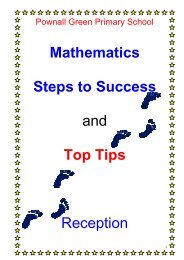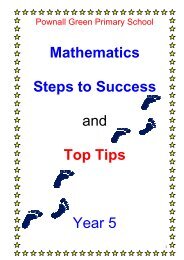Steps to Success and Top Tips - Pownall Green Primary School
Steps to Success and Top Tips - Pownall Green Primary School
Steps to Success and Top Tips - Pownall Green Primary School
You also want an ePaper? Increase the reach of your titles
YUMPU automatically turns print PDFs into web optimized ePapers that Google loves.
<strong>Pownall</strong> <strong>Green</strong> <strong>Primary</strong> <strong>School</strong><br />
Mathematics<br />
<strong>Steps</strong> <strong>to</strong> <strong>Success</strong><br />
<strong>and</strong><br />
<strong>Top</strong> <strong>Tips</strong><br />
Year 1<br />
1
Contents<br />
Page<br />
1. Count 20 things 3<br />
2. Count on <strong>and</strong> back in ones 3<br />
3. Count on <strong>and</strong> back in tens from 0 3<br />
4. Read, write <strong>and</strong> order numbers from 0 <strong>to</strong> 20 3<br />
5. Underst<strong>and</strong> <strong>and</strong> use words <strong>to</strong> compare <strong>and</strong> order<br />
numbers 4<br />
6. Say the number 1 more or less than a number 0<br />
<strong>to</strong> 30 4<br />
7. Say the number 10 more or less than a number<br />
0 <strong>to</strong> 30 4<br />
8. Add, take away <strong>and</strong> find the difference 4<br />
9. Know number bonds <strong>to</strong> 10 5<br />
10. Use doubling <strong>and</strong> halving 5<br />
11. To explain methods 5<br />
12. Measure a length, mass or capacity using<br />
non-st<strong>and</strong>ard units 6<br />
13. Measure a length, mass or capacity using<br />
st<strong>and</strong>ard units 6<br />
14. Use everyday language <strong>to</strong> describe familiar<br />
2-D shape 7<br />
15. Use everyday language <strong>to</strong> describe familiar<br />
3-D shape 7<br />
2
<strong>Steps</strong> <strong>to</strong> <strong>Success</strong> <strong>and</strong> <strong>Top</strong> <strong>Tips</strong>– Year 1<br />
Key Learning Objectives<br />
1. To count 20 things<br />
<strong>Steps</strong> <strong>to</strong> <strong>Success</strong><br />
1. Touch one object at a time <strong>and</strong> say the number name.<br />
2. Move the objects you have counted away from the others.<br />
<strong>Top</strong> <strong>Tips</strong><br />
• Put the objects in a line before you start.<br />
2.To count on <strong>and</strong> back in ones<br />
<strong>Top</strong> <strong>Tips</strong><br />
• Use a number line <strong>to</strong> help.<br />
• Count down <strong>to</strong> ‘blast off’.<br />
• Clap <strong>and</strong> count forwards <strong>and</strong> backwards – one clap for each<br />
number.<br />
3.To count on <strong>and</strong> back in tens from 0<br />
<strong>Top</strong> <strong>Tips</strong><br />
• Use a hundred square <strong>to</strong> help.<br />
• Make the pattern of the digits clear <strong>to</strong> the children e.g. units digit<br />
stays the same <strong>and</strong> the tens digit goes up by one each time.<br />
• Flash ten fingers as we count in 10’s.<br />
• Use ten 10p coins as objects <strong>to</strong> count.<br />
4.To read, write <strong>and</strong> order numbers from 0 <strong>to</strong> 20<br />
<strong>Top</strong> <strong>Tips</strong><br />
• Read– number recognition – use flash cards etc. Link the shape of<br />
numbers <strong>to</strong> animals <strong>and</strong> familiar objects e.g. 2 is a swan, 8 is a<br />
snowman.<br />
• Write – draw numbers in s<strong>and</strong>, make numbers out of play dough,<br />
write number on palm of your h<strong>and</strong> or trace with your fingers on a<br />
friend’s back.<br />
• Order - children hold number cards <strong>and</strong> make a human number line<br />
3
5.To underst<strong>and</strong> <strong>and</strong> use words <strong>to</strong> compare <strong>and</strong> order numbers<br />
<strong>Top</strong> <strong>Tips</strong><br />
• Adults uses language e.g. smaller/larger/greater/less/more.<br />
• Display the written words as well.<br />
6.To say the number 1 more or less than a number between 0-30<br />
<strong>Top</strong> <strong>Tips</strong><br />
• Use a number line <strong>to</strong> help.<br />
• Use fingers/objects if necessary.<br />
7.To say the number 10 more or less than a number between 0-30<br />
<strong>Top</strong> <strong>Tips</strong><br />
• Use a hundred square <strong>to</strong> help (move down the tens columns <strong>to</strong> add<br />
a 10 <strong>and</strong> up <strong>to</strong> subtract 10. Move along the rows <strong>to</strong> add 1 <strong>and</strong> back<br />
<strong>to</strong> takeaway).<br />
8.To add, take away <strong>and</strong> find the difference<br />
<strong>Steps</strong> <strong>to</strong> <strong>Success</strong> - Adding<br />
1. Put the biggest number in your head<br />
2. Count ON from the biggest number<br />
<strong>Top</strong> <strong>Tips</strong><br />
• Put up the number of fingers you want <strong>to</strong> add <strong>to</strong> the biggest number FIRST <strong>and</strong><br />
then put each finger down as you count on.<br />
• Use objects or pictures <strong>to</strong> model calculation.<br />
<strong>Steps</strong> <strong>to</strong> <strong>Success</strong> – Take away<br />
1. Put the first number in your head<br />
2. Count BACK from that number.<br />
<strong>Top</strong> <strong>Tips</strong><br />
• Put up the number of fingers you want <strong>to</strong> take away from the first number <strong>and</strong><br />
then put each finger down as you count back.<br />
• Use objects or pictures <strong>to</strong> model calculation.<br />
• Practice counting back taking it in turns with others.<br />
• Model finding the difference using 2 <strong>to</strong>wers of cubes - ask how can we make<br />
both <strong>to</strong>wers the same? Snap off the difference.<br />
• It’s easier <strong>to</strong> count on from the smallest number <strong>to</strong> the largest when finding the<br />
difference.<br />
4
9.To know number bonds <strong>to</strong> 10<br />
<strong>Top</strong> <strong>Tips</strong><br />
• Begin using ten fingers.<br />
• Use apparatus such as pegs on a coat hanger.<br />
• Encourage fast recall – memory.<br />
10.To use doubling <strong>and</strong> halving<br />
<strong>Top</strong> <strong>Tips</strong><br />
• Using fingers<br />
• Encourage fast recall – memory.<br />
• Use spots in butterfly wings <strong>to</strong> illustrate.<br />
11.To explain methods<br />
<strong>Top</strong> <strong>Tips</strong><br />
• Ask children <strong>to</strong> explain <strong>to</strong> a teddy or puppet who is struggling.<br />
5
<strong>Steps</strong> <strong>to</strong> <strong>Success</strong> <strong>and</strong> <strong>Top</strong> <strong>Tips</strong><br />
Shape, Space <strong>and</strong> Measures – Year 1<br />
Key Learning Objectives<br />
12. To measure a length, mass or capacity using non-st<strong>and</strong>ard units<br />
<strong>Top</strong> <strong>Tips</strong><br />
Length<br />
• Measure two objects by direct comparison.<br />
• Use a non-st<strong>and</strong>ard measure such as h<strong>and</strong> spans <strong>to</strong> estimate <strong>and</strong><br />
measure the length of an object.<br />
• Underst<strong>and</strong> <strong>and</strong> use in practical contexts the vocabulary of<br />
estimation<br />
Such as almost, close <strong>to</strong>, nearly.<br />
Mass<br />
• Use direct comparison <strong>to</strong> compare the mass of two different<br />
objects.<br />
• Use non-st<strong>and</strong>ard units <strong>to</strong> measure how much an object weighs.<br />
• Underst<strong>and</strong> <strong>and</strong> use in practical contexts language such as<br />
weight, heavy, light, balances.<br />
Capacity<br />
• Use direct comparison <strong>to</strong> compare the capacities of two different<br />
containers.<br />
• Use non-st<strong>and</strong>ard units <strong>to</strong> measure how much a container will<br />
hold.<br />
13. To measure a length, mass or capacity using st<strong>and</strong>ard units<br />
<strong>Top</strong> <strong>Tips</strong><br />
• Demonstrate that a metre = 100cm, a kg = 1000g <strong>and</strong> a litre =<br />
1000ml. Show a metre stick, feel a kg weight <strong>and</strong> look at a litre<br />
measure. Discuss the importance of st<strong>and</strong>ard units.<br />
• Make direct comparisons by finding or suggesting things e.g. Find<br />
objects that are longer/shorter than 1m/10cm/1cm<br />
• Use a balance <strong>to</strong> find out which objects are heavier/lighter<br />
than1kg,<br />
• Investigate which containers contain more/less than 1 litre<br />
• Compare two objects <strong>and</strong> say which is longer, heavier, holds more<br />
by measuring using st<strong>and</strong>ard units.<br />
6
14. To use everyday language <strong>to</strong> describe familiar 2-D shape<br />
<strong>Top</strong> <strong>Tips</strong><br />
• Use language: shape, flat, straight, curved, round, corner, side,<br />
edge, sort, circle, triangle, rectangle, square.<br />
• Identify circles, squares, triangles <strong>and</strong> rectangles.<br />
• Find shapes on faces of objects<br />
• Make shape pictures/patterns on paper <strong>and</strong> in the s<strong>and</strong> – names<br />
the shapes <strong>and</strong> describe the patterns.<br />
• Refer <strong>to</strong> the properties of shapes such as the number of corners<br />
<strong>and</strong> sides<br />
• Choose a flat shape that matches the properties described by the<br />
teacher E.g.:<br />
o Has four sides of the same length<br />
o Have four corners <strong>and</strong> two short sides <strong>and</strong> two long sides.<br />
• Feel a shape in a bag <strong>and</strong> name it.<br />
• Talk about the shapes <strong>and</strong> patterns in their environment <strong>and</strong> take<br />
digital pho<strong>to</strong>s<br />
Higher attaining pupils will also be able <strong>to</strong>:<br />
• Underst<strong>and</strong>, use <strong>and</strong> begin <strong>to</strong> read the vocabulary: pentagon,<br />
hexagon, octagon<br />
• Choose a shape <strong>to</strong> match the properties described by the teacher<br />
<strong>and</strong> name it e.g. Find a shape that has five corners <strong>and</strong> five<br />
sides. (pentagon)<br />
15. To use everyday language <strong>to</strong> describe familiar 3-D shape<br />
<strong>Top</strong> <strong>Tips</strong><br />
• Underst<strong>and</strong> use in a practical context: shape, solid, hollow, edge, face,<br />
straight, curved, point, corner<br />
• Recognise <strong>and</strong> name the following shapes: Cube, Cuboid, Sphere,<br />
Cylinder, Cone<br />
• Identify shapes in the classroom or at home: for example, find a<br />
cuboid (box) Cylinder (baked beans tin).<br />
• Choose a 3-D shape from a collection <strong>and</strong> describe its properties such<br />
as:<br />
- This shape has six faces <strong>and</strong> each face is a rectangle<br />
- The cube has 12 edges.<br />
• Make 3-D shapes using constructions kits, straws, clay, plasticine,<br />
everyday materials etc.<br />
• Begin <strong>to</strong> relate 3-D shapes <strong>to</strong> pictures of them e.g. match solids <strong>to</strong><br />
pictures of them, use bricks <strong>to</strong> build models from pictures.<br />
7







